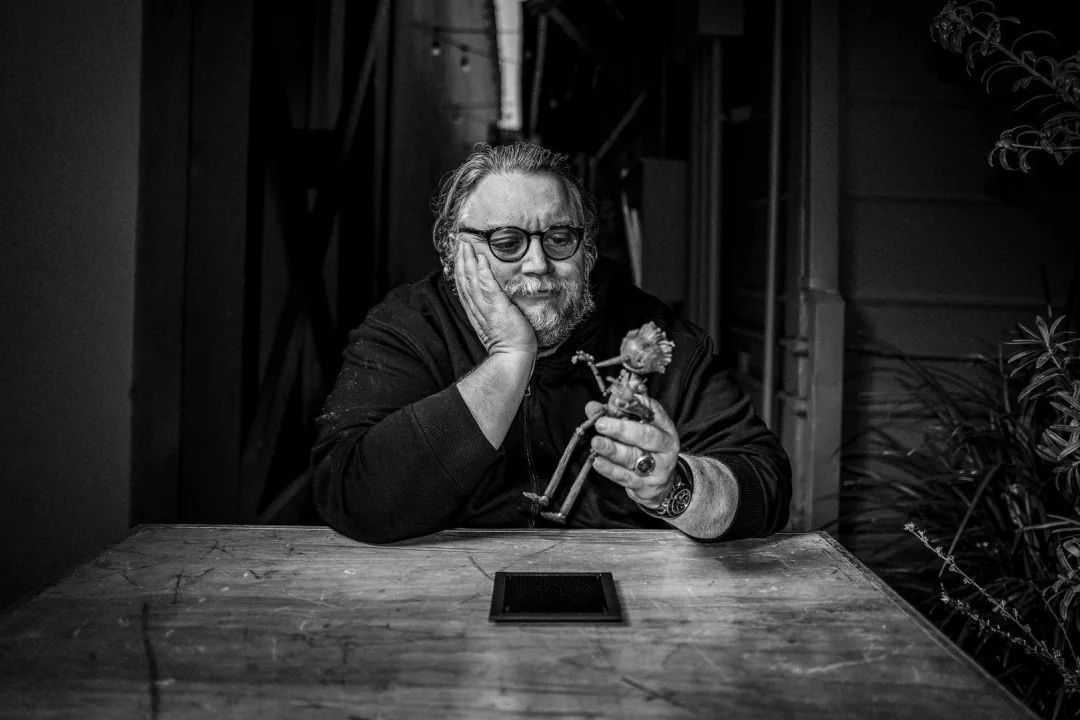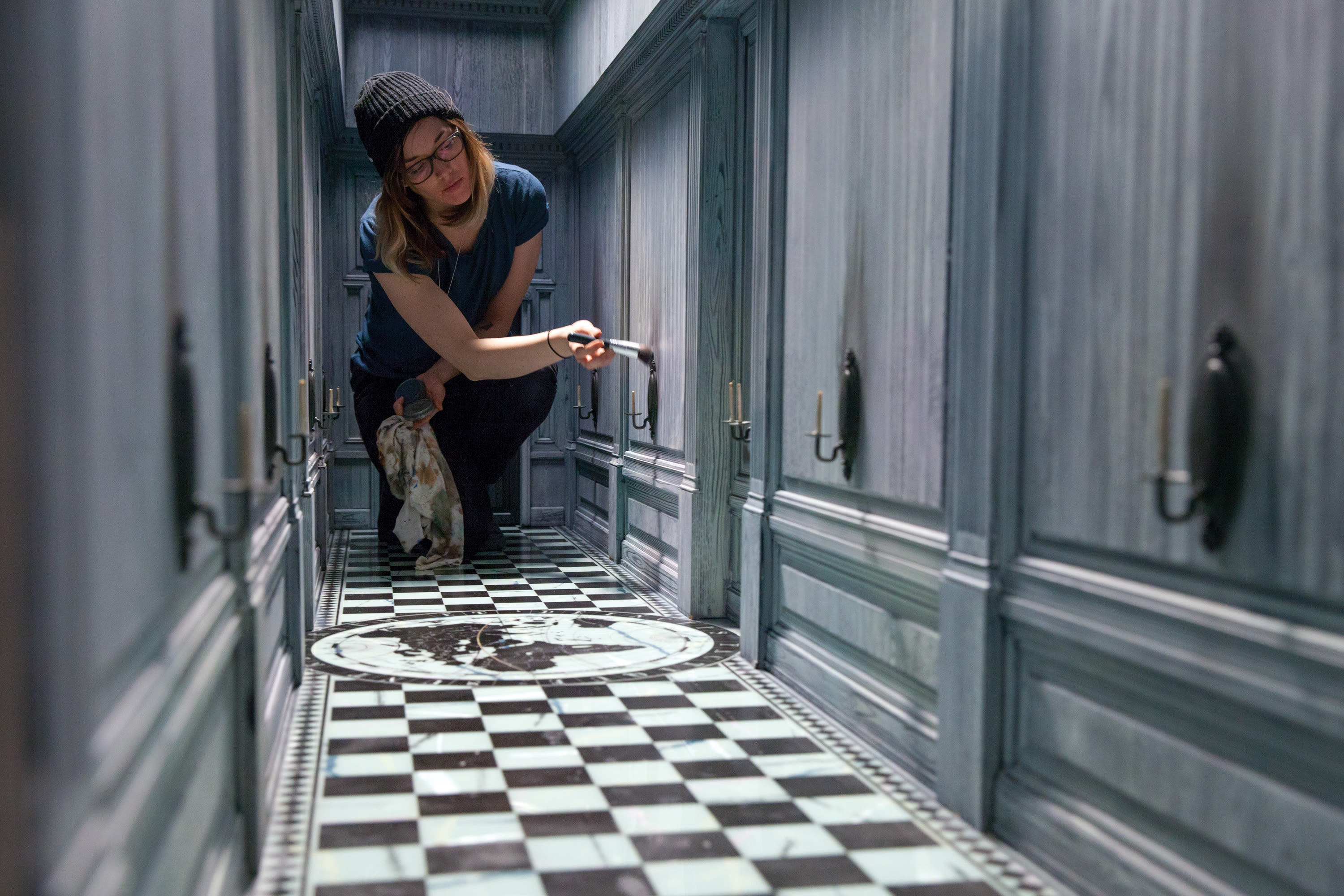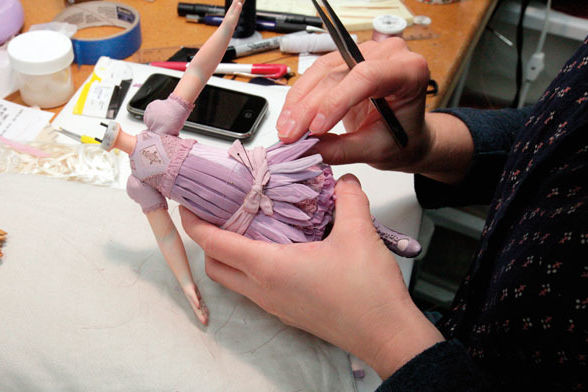Inside Guillermo del Toro’s Portland-Made Pinocchio
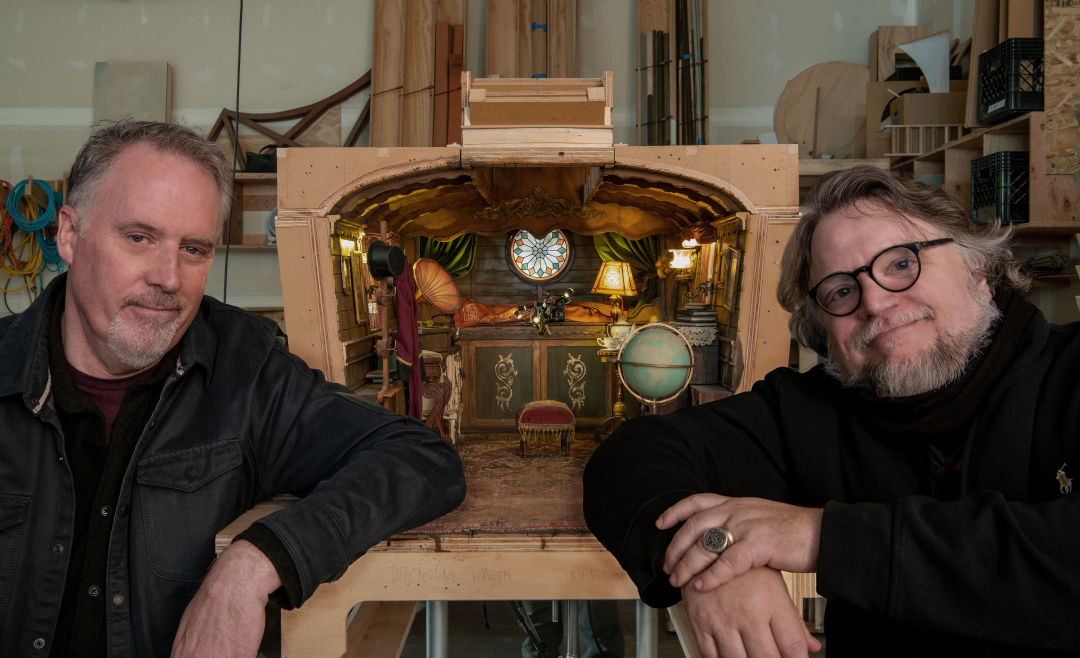
Mark Gustafson and Guillermo del Toro on the set of Pinocchio.
Image: Jason Schmidt/Netflix
A grief-stricken artisan wobbles through his studio, shaking off last night’s hangover. He hears a stirring in the attic, arms himself, and goes to investigate. Upstairs, an invader’s head swivels 360 degrees while his limbs contort into unholy shapes to avoid detection. His name is Pinocchio.
So goes our Evil Dead–adjacent intro to the titular puppet in Guillermo del Toro’s new stop-motion telling of the classic tale. By this point, about 15 minutes in, the Mexican fabulist has already made it clear we’re a long way from “When You Wish Upon a Star”: the film opens with an Up-style montage that establishes Gepetto as a grieving father and walks us through the horrors of World War I. The “Blue Fairy,” when she appears, is more biblically accurate angel than docile Disney sprite, slathered head to toe with eerie blinking eyes. Del Toro’s codirector, Mark Gustafson, puts it bluntly: “Guillermo brought his monsters to this thing.”
Some, like the terrifying dogfish that swallows Pinocchio, Gepetto, and the gang, will be familiar to lovers of the source material. Others, like the officers of Italian fascism who want to turn Pinocchio into a supersoldier, will be familiar to devotees of del Toro, who has long set his fairy tales against oppressive right-wing regimes. “From a story point of view, what was interesting was that we were turning the core conceit on its ear. That being: if you learn to be a good little boy, then you’ll be a real little boy,’” Gustafson says. “We said, ‘Well, what is the value in disobedience? By questioning things, that’s how you learn who you are.’ The fascism in the background was a nice way to contrast that. Everyone’s walking in lock step, and then there’s this anarchical element of Pinocchio that’s dropped into that world. He happens to actually be a puppet, but everybody else acts like puppets.”
Gustafson, a born-and-bred Portlander, has worked in stop-motion animation for nearly 40 years. Drawn to the form as a child when he first saw 1963’s Jason and the Argonauts, he took a teenage apprenticeship at Will Vinton Studios, which has parlayed into credits on everything from Chris Rock’s stop-motion sitcom The PJs to Wes Anderson’s Fantastic Mr. Fox. Pinocchio, though, is the largest-scale project Gustafson has ever worked on—and it isn’t close.
The film was shot predominantly at ShadowMachine’s offices in Northwest Portland, where production filled up an alarming amount of the company’s 75,000 square feet of studio space. “At our peak, we were running 60 units concurrently, which I believe is the first time that’s ever happened,” says Alex Bulkley, a cofounder of ShadowMachine and producer on Pinocchio. “Normal, rational people would go for more like 30 units.” More than 350 artists worked on the film, in total, and Bulkley estimates that their labor came to roughly a million “people hours.”
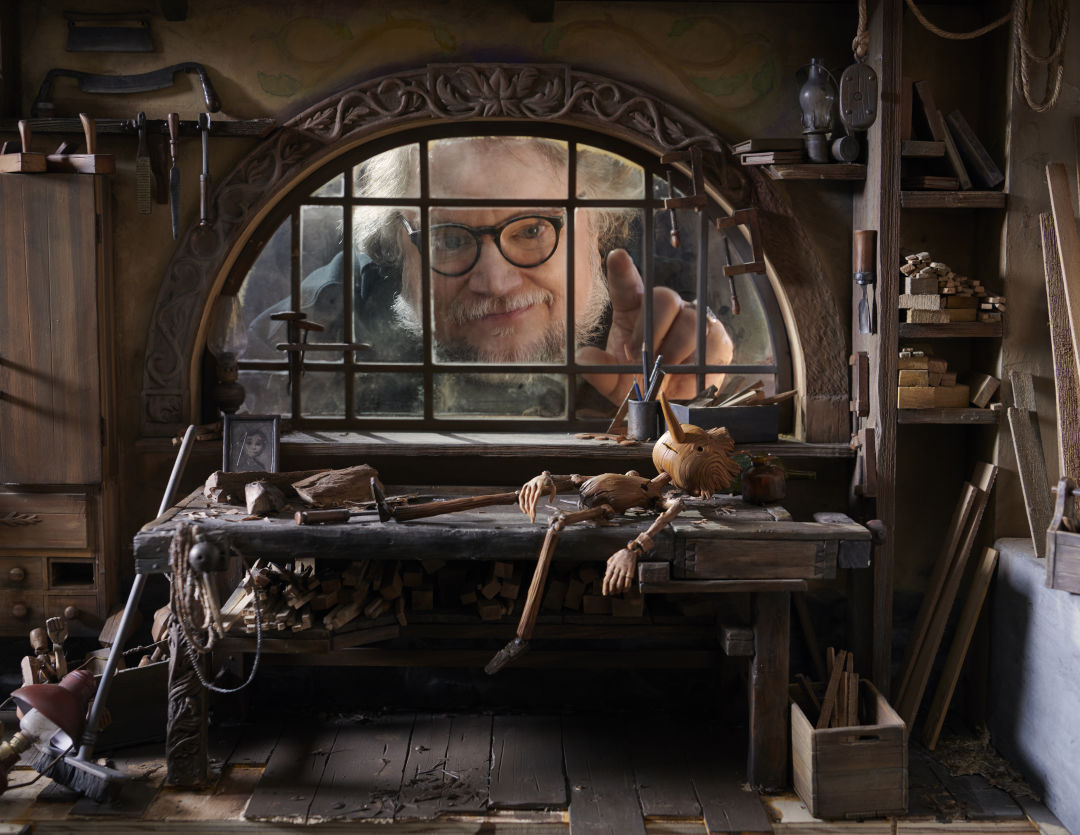
Guillermo del Toro on the Pinocchio set.
Image: Jason Schmidt/Netflix
Before Pinocchio was a technical feat, though, it was an idea in del Toro’s head, cobbled together from personal passions and professional connections. In high school, he trained his fellow students in stop-motion techniques. In interviews, he’s stated that “no single character in history has had as deep a personal connection to [him] as Pinocchio.” At various points over the past decade and a half, the director had been in talks with everyone from the Jim Henson Company to children’s book author Gris Grimly to assist him on the project.
By 2012, he locked in Gustafson and ShadowMachine as collaborators, and after years of honing the script and visuals, production began in earnest toward the end of 2019. (When COVID hit, animators started building sets and props at home and photographing what they could remotely. “It was like the film suddenly exploded all over Portland,” Gustafson says. “It wasn’t just happening in one studio. It was happening in houses and garages and basements.”)
The result is an idiosyncratic, unmistakably del Toro concoction. It centers on Gepetto (voiced by David Bradley), a grieving Italian carpenter who’s been kneecapped by the sudden loss of his son. After Mussolini rises to power, a benevolent cricket named Sebastian (Ewan McGregor) takes pity on Gepetto’s loneliness and summons a forest spirit (Tilda Swinton) to bring the carpenter’s latest wooden creation to life. Initially received both by Gepetto and his fellow citizens as an aberration, Pinocchio spends his days fighting to step out from the shadow of his surrogate father’s dead offspring.
The second and third acts of the film, as always, consist of Pinocchio’s disobedient picaresque: he falls in with scheming circus folk, attends fascist bootcamp against his will, and fights his way out of a sea monster. In a year with two Pinocchios—Disney also put out a live-action version directed by Robert Zemeckis in September, which suffered a critical beating—the most delicious beats in this one go where no other film version has. The wooden boy’s yearning to be human, for instance, has less to do with species envy and more to do with samsara. As a puppet, he’s cursed to a life of reincarnation: each time he dies, he’s thrust into a limbo populated with sand, black rabbits, and a sphinxlike death demon (also voiced by Swinton). The darkly whimsical design of these sequences is indelible, and it’s not even pure del Toro—there are, in fact, limbo rabbits in Collodi’s original tale, an element that Walt Disney and his imitators have conspicuously chosen to ignore.
It can be difficult, as a journalist, to suppress the urge to pick apart every single detail of how this two-hour film was imagined, designed, and executed. How did they get the chiaroscuro lighting just right in the chapel scenes? (A lot of math.) What’s the snow made of? (Depends; sometimes glue.) What happens when one of the characters breaks? (They go to the on-set “puppet hospital,” where tears and scrapes are triaged and treated.) It’s Gustafson’s hope, though, that viewers forget about the technique entirely once the movie gets into its rhythm. “Initially, you’re going to look at [the craft], but I hope you just dissolve into it and all that goes away within five minutes, and the characters are compelling enough and our story has enough momentum that you just don’t think about it,” he says. It’s to his and his collaborators’ credit that, at a certain point, you don’t.
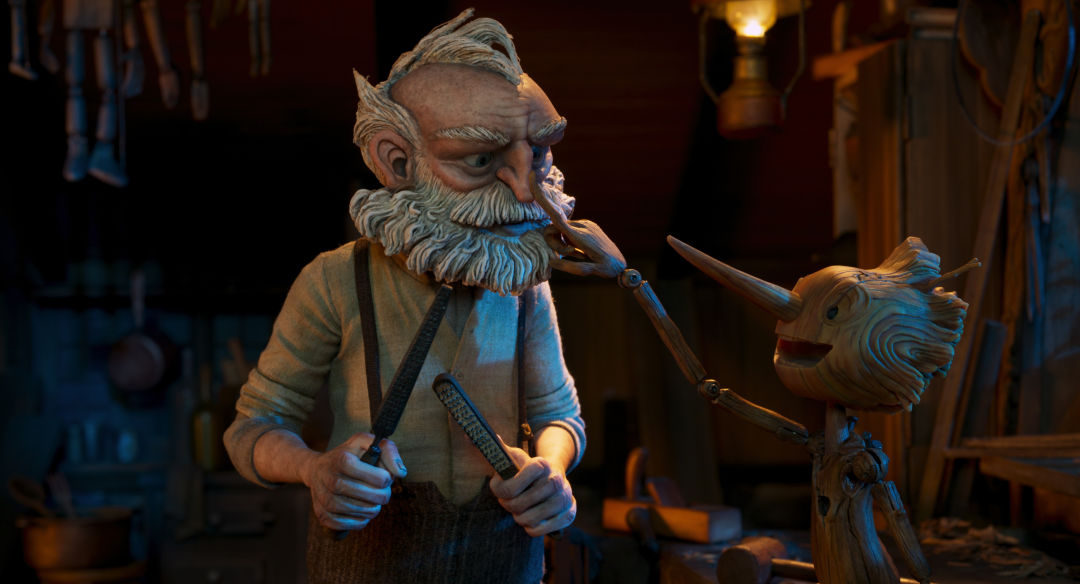
Gepetto (voiced by David Bradley) and Pinocchio (voiced by Gregory Mann) in Guillermo del Toro's Pinocchio.
Image: Courtesy Netflix
Indeed, del Toro didn’t pick the Rose City as the film’s artistic home base just because it was Gustafson’s hometown. “Portland is a bastion of some of the best stop-motion talent in the world,” Bulkley says. During production, Pinocchio shared personnel with Netflix’s Wendell & Wild, which came out in October, and Laika’s Wildwood, which is slated to hit theaters next year. It’s the only time in history that a city has hosted three feature-length stop-motion films at once.
“I suppose the cliché explanation would be all the rain—people want to be indoors,” says Gustafson, but he admits the roots date back to his former employer Will Vinton.
He stresses what a sweet deal it is: he never had to leave home, and got to make a career in an ultra-niche art form he’s loved for as long as he can remember, working with auteurs like del Toro and Anderson. “In some ways I never had to grow up. I’m able to just play with toys,” Gustafson says. “As I walk onto these sets and there are all these puppets and miniatures, I always tell myself, ‘Think of what 12-year-old you would think when he saw you standing here right now.’ He’d think, ‘Yep, you made it.’”
A career caring for inanimate objects and bringing them to life? Forgive the expression: it makes Gustafson's days sound a lot like Gepetto's. Just without quite so many strings.
